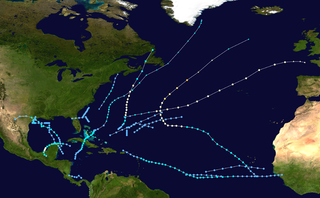The name Frances has been used for nine tropical cyclones worldwide: eight in the Atlantic Ocean and one in the Australian region.
In the Atlantic Ocean:
- Hurricane Frances (1961): Caused flooding in Puerto Rico, peaked at Category 4 west of Bermuda, subtropical at Nova Scotia
- Tropical Storm Frances (1968): Travelled across the central Atlantic Ocean without affecting land
- Hurricane Frances (1976): Curved over the central Atlantic, affected the Azores as an extratropical storm
- Hurricane Frances (1980): Travelled up the central Atlantic Ocean without affecting land
- Hurricane Frances (1986): Briefly drifted over the western Atlantic but never affected land
- Hurricane Frances (1992): Threatened Bermuda but did not strike the island, then hit Spain as an extratropical storm
- Tropical Storm Frances (1998): A weak storm that caused flooding in East Texas and southern Louisiana
- Hurricane Frances (2004): A powerful Category 4 hurricane that struck the Bahamas, and later, as a Category 2 storm, moved extremely slowly over Florida, causing billions in damage
After the 2004 season, the name Frances was retired and replaced by Fiona , which was first used during the 2010 season.
In the Australian region:
- Cyclone Frances (2017): A relatively strong tropical cyclone which remained off the coasts of Papua New Guinea, Indonesia and northern Australia.


